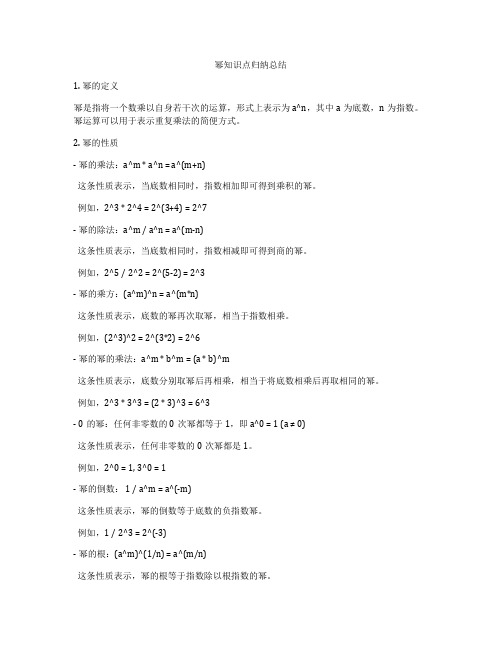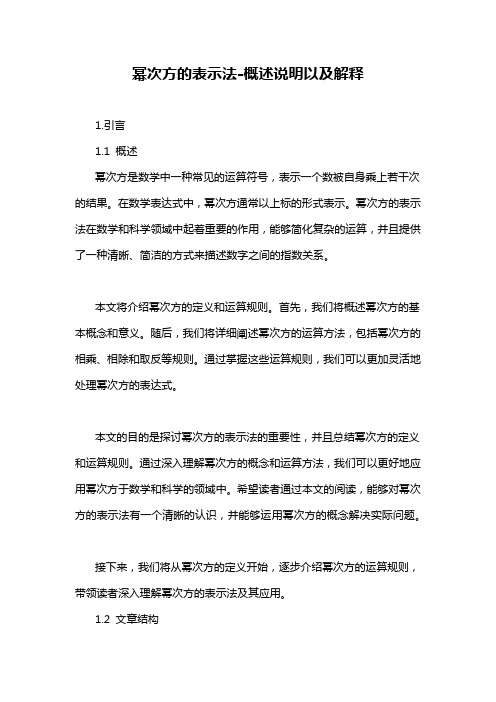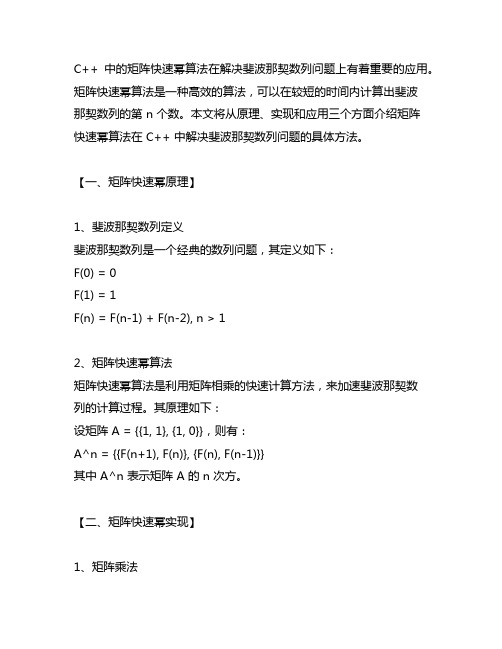a的n次方的快速算法
幂知识点归纳总结

幂知识点归纳总结1. 幂的定义幂是指将一个数乘以自身若干次的运算,形式上表示为a^n,其中a为底数,n为指数。
幂运算可以用于表示重复乘法的简便方式。
2. 幂的性质- 幂的乘法:a^m * a^n = a^(m+n)这条性质表示,当底数相同时,指数相加即可得到乘积的幂。
例如,2^3 * 2^4 = 2^(3+4) = 2^7- 幂的除法:a^m / a^n = a^(m-n)这条性质表示,当底数相同时,指数相减即可得到商的幂。
例如,2^5 / 2^2 = 2^(5-2) = 2^3- 幂的乘方:(a^m)^n = a^(m*n)这条性质表示,底数的幂再次取幂,相当于指数相乘。
例如,(2^3)^2 = 2^(3*2) = 2^6- 幂的幂的乘法:a^m * b^m = (a * b)^m这条性质表示,底数分别取幂后再相乘,相当于将底数相乘后再取相同的幂。
例如,2^3 * 3^3 = (2 * 3)^3 = 6^3- 0的幂:任何非零数的0次幂都等于1,即a^0 = 1 (a ≠ 0)这条性质表示,任何非零数的0次幂都是1。
例如,2^0 = 1, 3^0 = 1- 幂的倒数: 1 / a^m = a^(-m)这条性质表示,幂的倒数等于底数的负指数幂。
例如,1 / 2^3 = 2^(-3)- 幂的根:(a^m)^(1/n) = a^(m/n)这条性质表示,幂的根等于指数除以根指数的幂。
例如,(2^4)^(1/2) = 2^(4/2) = 2^2- 幂的负指数:a^(-n) = 1 / a^n (a ≠ 0)这条性质表示,幂的负指数等于倒数的幂。
例如,2^(-3) = 1 / 2^33. 幂的几何意义在几何学中,幂也可以用来表示长度、面积和体积。
- 长度:如果一个线段的长度为a,那么a^n表示这条线段的n次方长。
- 面积:如果一个正方形的边长为a,那么a^n表示这个正方形的n次方面积。
- 体积:如果一个立方体的边长为a,那么a^n表示这个立方体的n次方体积。
求矩阵的n次幂有如下几个常用方法

求矩阵的n次幂有如下几个常用方法1、求矩阵的n次幂的矩阵乘法法:求矩阵的n次幂的矩阵乘法法是用矩阵的乘法来求n次幂的一种方法,假设n>1。
令A为一个n阶矩阵,将A^n表示为A•A•…•A(n个A表示n次乘积),这样就可以用矩阵的乘法运算,把矩阵的n次幂表示出来。
这种方法适合任意阶数的矩阵,但是运算量大,一般在n大于4时会给计算机造成较大压力。
快速乘法法是将连乘拆成若干小段,用平方法计算这些小段,最后把平方结果合成出原来的积,这样就可以利用矩阵的平方法降低运算的复杂度,近似时间复杂度仅为O(logn)。
遗传算法(GA)是一种模拟自然辅助搜索算法,其可利用遗传运算(Genetic Operation)求解难以用传统算法求解的复杂问题,也可用来求矩阵的n次幂。
此方法通过使用遗传运算对n次幂矩阵A求解,其中有“选择(selection)”、“交叉(crossover)”、“变异(mutation)”等随机算法组成,在一定时间内,做出一定代数运算就能求出矩阵的n次幂,这种方法的效率取决于遗传算子的设计,但是因为这种方法涉及较少的运算,所以可能运算效率会很高。
线性矩阵分解法是把矩阵A事先分解成正交矩阵和对角矩阵的向量形式,将n次幂矩阵A^n分解成m分,从而减少计算量,缩短计算时间。
这种方法可以有效减少计算过程的数量,但对于大矩阵来说,可能由于分解矩阵的复杂度过高而无法令效率上升。
树结构法是一种求解n次方矩阵A的技术,它是建立树,由树的叶节点求出矩阵A的n次方。
由于每一层都有一个乘积,树结构法可以有效减少计算次数,较为高效。
通常来说,这种方法的复杂度降低到O(logn)。
总之,上面提到的几种方法都可以用来求矩阵的n次幂,根据矩阵的阶数和n的大小,可以合理选择合适的算法,从而提高求解效率。
n次方的计算公式

n次方的计算公式是指幂次方的计算公式,即计算一个数的n次方的值。
它是数学中一个重要的概念,也是进行数学计算的基础。
下面就为大家介绍n次方的计算公式。
首先,我们要弄清楚什么是n次方,它是什么意思。
n次方是指一个数的n倍乘积,即x的n次方的定义为x的乘积,其中x的乘积重复n次。
例如,2的4次方,表示2乘以2乘以2乘以2,即2的4次方等于16。
其次,n次方的计算公式是什么?n次方的计算公式是幂乘法公式,即x^n=x×x×x×…×x(n次)。
例如,2的4次方,就可以用2^4=2×2×2×2,即计算出2的4次方等于16。
再次,还有一些特殊情况也需要考虑。
如果计算的n次方小于0,则需要用分数的形式表示,例如2的-2次方,即2^-2=1/(2×2)=1/4。
如果计算的n次方是小数,则用幂函数的形式表示,例如2的1.5次方,可以用y=2^1.5表示。
最后一点,在计算n次方的时候,可以使用指数符号表示,例如2^3可以写成2³,表示2的3次方等于8。
总之,n次方的计算公式是一个重要的数学概念,可以使用幂乘法公式来计算,也可以使用指数符号的形式来表示,并且还要考虑特殊情况,如n次方小于0或者是小数的情况。
快速计算幂塔算法

快速计算幂塔算法全文共四篇示例,供读者参考第一篇示例:快速计算幂塔算法(Exponentiation by squaring),是一种用于快速计算一个数的幂的算法。
它是通过分治思想,将幂指数进行二分拆分,并利用指数的奇偶性质来减少计算量,从而提高计算效率。
这个算法在计算机科学中得到了广泛的应用,特别是在密码学、图论等领域。
让我们来看一个简单的例子,假设我们要计算2^{10}。
传统的方法是进行10次乘法运算,即2*2*2*2*2*2*2*2*2*2。
而利用快速计算幂塔算法,我们可以通过以下步骤来计算:1. 将指数10拆分成二进制形式,得到10=1010_2;2. 将底数2进行平方操作,得到2^2=4;3. 根据二进制形式的每一位来进行累积运算,当遇到1的位时,将前一步计算结果进行乘法操作。
最终得到2^{10}=1024。
可以看到,利用快速计算幂塔算法,我们只需要进行四次乘法运算即可得到2^{10}的结果,而传统的方法需要进行10次乘法运算。
这就是快速计算幂塔算法的高效之处。
快速计算幂塔算法的核心思想是分治策略。
它将指数的二进制拆分成若干个二进制位,每次根据当前位数是0还是1来进行乘法或平方操作,并将结果进行累积。
通过这种方式,可以大大减少计算量。
具体来说,算法的流程可以描述为以下几步:1. 将指数n表示为二进制形式n=b_k*2^k+b_{k-1}*2^{k-1}+...+b_0*2^0;2. 从最高位开始,根据每一位的值b_i,进行不同的操作:- 当b_i=0时,进行平方操作;- 当b_i=1时,进行乘法操作;3. 重复上述步骤,直到计算完所有的位数,得到最终结果。
通过这种方法,可以将指数的计算复杂度从O(n)降低到O(\log n),极大地提高了计算效率。
在实际应用中,快速计算幂塔算法常常用于RSA加密算法、模幂取模运算等领域,可以大大缩短计算时间,提高系统的效率和安全性。
快速计算幂塔算法是一种高效的计算幂运算的算法,它通过分治策略和二进制拆分的方法,可以快速准确地计算任意数的幂。
幂次方的表示法-概述说明以及解释

幂次方的表示法-概述说明以及解释1.引言1.1 概述幂次方是数学中一种常见的运算符号,表示一个数被自身乘上若干次的结果。
在数学表达式中,幂次方通常以上标的形式表示。
幂次方的表示法在数学和科学领域中起着重要的作用,能够简化复杂的运算,并且提供了一种清晰、简洁的方式来描述数字之间的指数关系。
本文将介绍幂次方的定义和运算规则。
首先,我们将概述幂次方的基本概念和意义。
随后,我们将详细阐述幂次方的运算方法,包括幂次方的相乘、相除和取反等规则。
通过掌握这些运算规则,我们可以更加灵活地处理幂次方的表达式。
本文的目的是探讨幂次方的表示法的重要性,并且总结幂次方的定义和运算规则。
通过深入理解幂次方的概念和运算方法,我们可以更好地应用幂次方于数学和科学的领域中。
希望读者通过本文的阅读,能够对幂次方的表示法有一个清晰的认识,并能够运用幂次方的概念解决实际问题。
接下来,我们将从幂次方的定义开始,逐步介绍幂次方的运算规则,带领读者深入理解幂次方的表示法及其应用。
1.2 文章结构本文主要介绍幂次方的表示法。
文章分为三个主要部分,即引言、正文和结论。
在引言部分,我们将概述整篇文章的内容,包括幂次方的定义、运算规则以及表示法的重要性。
通过引言,读者可以对文章的主题有所了解,并对幂次方的表示法的研究意义有所把握。
正文部分是本文的核心部分,将详细阐述幂次方的定义和运算规则。
我们将通过详细的解释和举例来说明幂次方的概念,并介绍幂次方的运算规则,包括相同底数相乘的规则、幂次方与乘法的关系以及幂次方的乘法法则等。
通过这些运算规则的介绍,读者可以更深入地了解幂次方的性质和运算特点。
在结论部分,我们将强调幂次方的表示法的重要性,并总结全文的主要内容。
通过对幂次方表示法的重要性的讨论,我们可以理解为什么需要研究和使用幂次方的表示法,以及它对数学和其他领域的应用价值。
总之,本文分为引言、正文和结论三个部分,通过这样的结构,我们将全面介绍幂次方的表示法,帮助读者更好地理解和应用幂次方的概念和运算规则。
c++ 矩阵快速幂 斐波那契数列

C++ 中的矩阵快速幂算法在解决斐波那契数列问题上有着重要的应用。
矩阵快速幂算法是一种高效的算法,可以在较短的时间内计算出斐波那契数列的第 n 个数。
本文将从原理、实现和应用三个方面介绍矩阵快速幂算法在 C++ 中解决斐波那契数列问题的具体方法。
【一、矩阵快速幂原理】1、斐波那契数列定义斐波那契数列是一个经典的数列问题,其定义如下:F(0) = 0F(1) = 1F(n) = F(n-1) + F(n-2), n > 12、矩阵快速幂算法矩阵快速幂算法是利用矩阵相乘的快速计算方法,来加速斐波那契数列的计算过程。
其原理如下:设矩阵 A = {{1, 1}, {1, 0}},则有:A^n = {{F(n+1), F(n)}, {F(n), F(n-1)}}其中 A^n 表示矩阵 A 的 n 次方。
【二、矩阵快速幂实现】1、矩阵乘法在 C++ 中,可以通过重载运算符实现矩阵的相乘操作。
代码如下:```cpp// 重载矩阵乘法Matrix operator*(const Matrix a, const Matrix b) {Matrix c;for (int i = 0; i < 2; i++) {for (int j = 0; j < 2; j++) {c.m[i][j] = 0;for (int k = 0; k < 2; k++) {c.m[i][j] += a.m[i][k] * b.m[k][j];}}}return c;}```2、矩阵快速幂算法利用矩阵乘法和快速幂算法,可以很容易地实现矩阵快速幂算法。
具体代码如下:```cpp// 矩阵快速幂算法Matrix matrixPow(Matrix a, int n) {Matrix res;res.init(); // 初始化单位矩阵while (n) {if (n 1) res = res * a;a = a * a;n >>= 1;}return res;}```【三、矩阵快速幂应用】1、斐波那契数列求解利用矩阵快速幂算法,可以在 O(logn) 的时间复杂度内求解斐波那契数列的第 n 个数。
次方的简便运算公式

次方的简便运算公式主要有三个:
1. a^n = n个a连乘。
2. a^n = a的n次方,其中a和n是正整数。
3. a^n = a的n次幂,其中a和n是正整数。
这些公式可以用于快速计算次方,例如:
1. 3^4 = 3 ×3 ×3 ×3 = 81。
2. 4^3 = 4 ×4 ×4 = 64。
3. 5^2 = 5 ×5 = 25。
此外,还有一些次方的性质和定理,例如:
1. (a^m)^n = a^(mn),即a的m次方的n次方等于a的mn次方。
2. (ab)^n = a^n ×b^n,即(ab)的n次方等于a的n次方乘以b的n次方。
3. (a^n)^m = a^(mn),即a的n次方的m次方等于a的mn次方。
4. a^(m+n) = a^m ×a^n,即a的m+n次方等于a的m次方乘以a的n次方。
5. a^(mn) = (a^m)^n,即a的mn次方等于a的m次方的n次方。
6. (a^m)^(-n) = (1/a^m)^n,即a的-mn次方等于1除以a的m次
方的n次方。
7. (1/a)^n = 1/a^n,即a的倒数的n次方等于1除以a的n次方。
8. (a/b)^n = a^n / b^n,即a除以b的n次方等于a的n次方除以b的n次方。
二进制指数后退算法的特点

二进制指数后退算法的特点
二进制指数后退算法是一种用于快速计算幂运算的算法。
它的特点是可以在O(log n)的时间复杂度内计算出a^n的值,其中a和n都是正整数。
这个算法的核心思想是将指数n用二进制表示,然后从低位到高位依次计算a的2的幂次方,最后将这些幂次方相乘得到a^n的值。
具体来说,二进制指数后退算法的步骤如下:
1. 将指数n用二进制表示,得到n的二进制位数k和k个二进制位b1,b2,...,bk,其中bk是n的最高位。
2. 初始化一个变量result为1,表示a^0的值。
3. 从低位到高位依次遍历二进制位b1,b2,...,bk,如果bi为1,则将result乘以a的2的i-1次幂,即result = result * a^(2^(i-1))。
4. 遍历完所有二进制位后,result的值即为a^n的值。
二进制指数后退算法的优点是速度快,时间复杂度为O(log n),比朴素的幂运算算法要快得多。
这个算法的原理是利用了指数的二进制表示中的位运算性质,将指数分解成若干个2的幂次方的乘积,然后利用乘法的结合律和交换律,将这些幂次方相乘得到最终结果。
在实际应用中,二进制指数后退算法常用于密码学中的加密和解密算法,以及计算机图形学中的矩阵变换等领域。
由于它的时间复杂
度较低,可以快速计算出大数的幂运算,因此在计算密集型的应用中具有重要的作用。
二进制指数后退算法是一种高效的幂运算算法,具有时间复杂度低、速度快的特点,广泛应用于密码学和计算机图形学等领域。
∑a的n次方求和公式

∑a的n次方求和公式让我们来看一个简单的例子,以加深对这个公式的理解。
假设我们要计算1到5的和,即∑(n=1到5) n。
根据公式,我们需要将1的n次方加到5的n次方,并将它们相加。
这样,我们就得到了1+2+3+4+5=15。
可以看出,这个公式为我们提供了一种快速计算和的方法。
接下来,让我们来讨论一下公式的应用。
求和公式在数学和物理中具有广泛的应用。
例如,在数列中,我们可以使用这个公式来计算数列的和。
假设我们有一个等差数列,前五项分别为1、3、5、7、9。
我们可以使用公式∑(n=1到5) (2n-1)来计算这个数列的和。
按照公式,我们将1的n次方加到9的n次方,并将它们相加。
计算结果为1+3+5+7+9=25。
因此,这个等差数列的和为25。
除了数列,求和公式还可以应用于几何学中的面积和体积计算。
例如,我们可以使用这个公式来计算正方形的面积。
假设我们有一个边长为a的正方形,我们想要计算它的面积。
根据公式,我们可以将正方形的边长a的n次方相加,即∑(n=1到4) a^n。
按照公式,我们将a的1次方加到a的4次方,并将它们相加。
计算结果为a+a^2+a^3+a^4。
因此,正方形的面积为a+a^2+a^3+a^4。
除了上述例子,求和公式还可以应用于金融学中的财务分析。
例如,在投资分析中,我们可以使用这个公式来计算未来现金流的现值。
假设我们有一系列未来现金流,每年的现金流量分别为C1、C2、C3、C4、C5,我们想要计算它们的现值。
根据公式,我们可以将每年的现金流量C的n次方相加,即∑(n=1到5) C^n。
按照公式,我们将C1的1次方加到C5的5次方,并将它们相加。
计算结果为C1+C2+C3+C4+C5。
因此,这些未来现金流的现值为C1+C2+C3+C4+C5。
求和公式是一种非常有用的工具,可以帮助我们快速计算一系列数的和。
它在数学、物理、几何学和金融学等领域都有广泛的应用。
通过使用这个公式,我们可以轻松地计算数列的和、几何图形的面积和体积,以及未来现金流的现值。
线性代数a的n次方

一.线性代数a的n次方怎么求?
1、计算A^2,A^3 找规律,然后用归纳法证明。
2、若r(A)=1,则A=αβ^T,A^n=(β^Tα)^(n-1)A
注:β^Tα=α^Tβ= tr(αβ^T)
3、分拆法:A=B+C,BC=CB,用二项式公式展开。
适用于B^n 易计算,C的低次幂为零:C^2 或C^3 = 0
4、用对角化A=P^-1diagP
A^n = P^-1diag^nP
扩展资料:
将一个矩阵分解为比较简单的或具有某种特性的若干矩阵的和或乘积,矩阵的分解法一般有三角分解、谱分解、奇异值分解、满秩分解等。
在线性代数中,相似矩阵是指存在相似关系的矩阵。
相似关系是两个矩阵之间的一种等价关系。
两个n×n矩阵A与B为相似矩阵当且仅当存在一个n×n的可逆矩阵P。
一个矩阵A的列秩是A的线性独立的纵列的极大数目。
类似地,行秩是A的线性无关的横行的极大数目。
通俗一点说,如果把矩阵看成一个个行向量或者列向量,秩就是这些行向量或者列向量的秩,也就是极大无关组中所含向量的个数。
a的n次幂求和公式

a的n次幂求和公式好嘞,以下是为您生成的关于“a 的 n 次幂求和公式”的文章:在咱们学习数学的这一路上,有各种各样的公式就像一个个神秘的宝藏,等着咱们去挖掘和掌握。
今天咱们就来聊聊“a 的 n 次幂求和公式”这个有趣的家伙。
先来说说这个公式到底是啥。
简单来讲,它就是能把一堆 a 的不同次幂相加给算出一个简洁结果的神奇工具。
比如说,a 的 0 次幂加上 a的1 次幂,一直加到a 的n 次幂,用这个公式就能一下子算出总和来。
那这个公式到底有啥用呢?我给您讲个事儿。
有一次我去逛商场,看到一个促销活动。
商家摆出了一堆商品,每种商品的价格都不一样,但是呢,它们的价格恰好构成了一个类似于 a 的 n 次幂的数列。
比如说,第一件商品价格是 2 的 0 次幂乘以一个固定的系数,第二件就是 2 的 1 次幂乘以那个系数,以此类推。
我当时就在心里默默用这个求和公式算了一下,如果我把这一系列商品全买下来得花多少钱。
算完之后,我心里就有底了,知道自己能不能承受这个消费。
您瞧,这公式在生活中是不是还挺实用的?咱们再深入聊聊这个公式的推导过程。
这就像是搭积木一样,一步一步来。
先从最简单的情况开始,慢慢增加难度,最后就把这个公式给推导出来了。
这个过程中,需要运用到一些巧妙的数学思维和方法。
而且啊,在学习这个公式的时候,很多同学一开始可能会觉得有点头疼,觉得这东西太抽象,不好理解。
其实啊,只要多做几道练习题,多琢磨琢磨,就能慢慢找到感觉。
比如说,咱们可以先从一些具体的数字代入开始,看看公式是怎么运作的。
就像我之前说的那个商场的例子,通过实际的数字去感受公式的魅力。
还有哦,这个公式和其他数学知识也有着千丝万缕的联系。
比如说等比数列,它和“a 的 n 次幂求和公式”就像是一对好兄弟,相互关联,相互支持。
在实际应用中,无论是解决数学问题,还是在其他学科,甚至是在日常生活中的一些小计算里,这个公式都可能会派上用场。
比如说,在物理学中计算一些有规律的量的总和,在经济学中分析一些数据的变化趋势,都可能会用到它。
a的n次方的快速算法

a的n次方的快速算法en二进制幂对于a的n次幂求解这个问题,不少人看到后都觉得没有什么内容吧!我第一次想到这个问题也觉得没有什么内容,但是后来仔细想想,里面还真是有学问哦!想想看如果我们求 a8 ,有以下两种方法1. a8 = a * a * a * a * a * a * a * a 需要计算 7次乘法2.a 8 = (a * a) * A * A (其中A = a * a) 需要计算3次乘法对于这么简单的一个算法计算步骤差别的差别是很大的,那么对于一个通常的n怎么表示普遍的求解方法呢?经过多天的思考,始终没有结果,今天突然在一本书上看到有关这个求解的算法,心中大喜。
把解决办法稍微整理一下,然后给出具体代码。
算法的思想一般的对于 a (2x + b) = a2x * a b所以就有(b = 0时 ) : a 2x + b = (ax)2 ;(b = 1时): a 2x + b = (a x)2 * a ;对于 an ,先把 n的二进制表示写出,那么有an = a (n1 n2 n3 n4 ..)(2) = …那么我们从左到右就可以如下表(n = 13的时候 1101)n的二进制位111累乘aa2 * a = a3(a3)2 = a6(a6)2 * a = a13第一种代码:(用java实现,用了函数调用,效果比较失败)package alg;public class AN {public static final int EXIT = 3;int a; // 底数int bin; // 指数public Stack s ;public AN(int a, int bin) {this.a = a;this.bin = bin;s = new Stack();s.push(EXIT);// 作为最后一个的标志toBin(bin);}public void renew( int a,int bin){ this.a = a ;this.bin = bin ;s.push(EXIT);// 作为最后一个的标志toBin(bin);}// 从左往右算public int leftT oRight() {int i;int result = 1;while (true) {i = s.pop();switch (i) {case 0:result *= result;break;case 1:result = result * result * a; break;case EXIT:return result;}}}public int rightToLeft(int a) { return 0;}/*** 把十进制转成二进制压入栈中** @param ten*/public Stack toBin(int ten) {int temp = ten;int rest;do {rest = temp % 2;temp = (temp - rest) / 2;s.push(rest);} while (temp != 0);return s ;}public static void main(String[] args) {AN a = new AN(3, 15);Stack s = new Stack();long start = System.currentTimeMillis();for (int i = 0; i < 100000 ; i++) {a.leftToRight();a.renew(3,15);}System.out.println("use cq's method use time:" + (System.currentTimeMillis() - start));int test = 1 ;start = System.currentTimeMillis();for(int i = 0 ; i < 100000 ; i++){test = 1 ;for(int j = 0 ; j < 15 ; j++){test *= 3;}}System.out.println("use nomarl method use time:"+ (System.currentTimeMillis() - start));}}运行结果:use cq's method use time:62use nomarl method use time:16我的运算居然比基本的要慢!郁闷中!我决定改一下方法了!尽量减少函数调用!改后的代码是public class AN{public static void main(String[]args){double a = 2.123 ;int bin = 31 ;long start = System.currentTimeMillis();for (int i = 0; i < 1000000 ; i++) {Stack s = new Stack();s.push(3);int temp = bin ;int rest;do {rest = temp % 2;temp = (temp - rest) / 2;s.push(rest);} while (temp != 1);s.pust(temp);long high = 0;double result = 1;while (high != 3) {high = s.pop();switch ((int)high) {case 0:result *= result;break;case 1:result = result * result * a;break;}}}System.out.println("use cq's method use time:"+ (System.currentTimeMillis() - start));long test = 1 ;start = System.currentTimeMillis();for(long i = 0 ; i < 1000000 ; i++){for(long j = 0 ; j < 31 ; j++){test *= 2.123;}}System.out.println("use nomarl method use time:"+ (System.currentTimeMillis() - start));}}运算结果:use cq's method use time:453use nomarl method use time:17265对两种结果的分析:Java的方法调用虽然相对其他语言来讲是做了优化的,但是仍然有一定开销,在做大量计算的时候仍然不能忽视。
- 1、下载文档前请自行甄别文档内容的完整性,平台不提供额外的编辑、内容补充、找答案等附加服务。
- 2、"仅部分预览"的文档,不可在线预览部分如存在完整性等问题,可反馈申请退款(可完整预览的文档不适用该条件!)。
- 3、如文档侵犯您的权益,请联系客服反馈,我们会尽快为您处理(人工客服工作时间:9:00-18:30)。
}
}
运行结果:
use cq's method use time:62
use nomarl method use time:16
我的运算居然比基本的要慢!郁闷中!我决定改一下方法了!尽量减少函数调用!
改后的代码是
public class AN{
public static void main(String[]args){
2.a 8 = (a * a) * A * A (其中A = a * a) 需要计算3次乘法
对于这么简单的一个算法计算步骤差别的差别是很大的,那么对于一个通常的n怎么表示
普遍的求解方法呢?
经过多天的思考,始终没有结果,今天突然在一本书上看到有关这个求解的算法,心中大喜。把解决办法稍微整理一下,然后给出具体代码。
test *= 3;
}
}
System.out.println("use nomarl method use time:"
+ (System.currentTimeMillis() ,不少人看到后都觉得没有什么内容吧!我第一次想到这个问题也觉得没有什么内容,但是后来仔细想想,里面还真是有学问哦!
想想看如果我们求 a8 ,有以下两种方法
1. a8 = a * a * a * a * a * a * a * a 需要计算 7次乘法
s.push(rest);
} while (temp != 0);
return s ;
}
public static void main(String[] args) {
AN a = new AN(3, 15);
那么我们从左到右就可以如下表(n = 13的时候 1101)
n的二进制位
1
1
0
1
累乘
a
a2 * a = a3
(a3)2 = a6
(a6)2 * a = a13
第一种代码:(用java实现,用了函数调用,效果比较失败)
package alg;
public class AN {
第二中方法效果明显是因为a是一个小数,这样 a*a的计算时间就长了,如果 a是整数的话计算时间过短,那么算法的速度就体现不出来了。
算法的思想
一般的对于 a (2x + b) = a2x * a b
所以就有
(b = 0时 ) : a 2x + b = (ax)2 ;
(b = 1时): a 2x + b = (a x)2 * a ;
对于 an ,先把 n的二进制表示写出,那么有
an = a (n1 n2 n3 n4 ..)(2) = …
Stack<Integer> s = new Stack<Integer>();
s.push(3);
int temp = bin ;
int rest;
do {
rest = temp % 2;
a.renew(3,15);
}
System.out.println("use cq's method use time:"
+ (System.currentTimeMillis() - start));
double result = 1;
while (high != 3) {
high = s.pop();
switch ((int)high) {
case 0:
result *= result;
public static final int EXIT = 3;
int a; // 底数
int bin; // 指数
public Stack<Integer> s ;
public AN(int a, int bin) {
System.out.println("use cq's method use time:"
+ (System.currentTimeMillis() - start));
long test = 1 ;
start = System.currentTimeMillis();
break;
case 1:
result = result * result * a;
break;
case EXIT:
return result;
int i;
int result = 1;
while (true) {
i = s.pop();
switch (i) {
case 0:
result *= result;
int test = 1 ;
start = System.currentTimeMillis();
for(int i = 0 ; i < 100000 ; i++){
test = 1 ;
for(int j = 0 ; j < 15 ; j++){
+ (System.currentTimeMillis() - start));
}
}
运算结果:
use cq's method use time:453
use nomarl method use time:17265
对两种结果的分析:
Java的方法调用虽然相对其他语言来讲是做了优化的,但是仍然有一定开销,在做大量计算的时候仍然不能忽视。
for(long i = 0 ; i < 1000000 ; i++){
for(long j = 0 ; j < 31 ; j++){
test *= 2.123;
}
}
System.out.println("use nomarl method use time:"
this.a = a ;
this.bin = bin ;
s.push(EXIT);// 作为最后一个的标志
toBin(bin);
}
// 从左往右算
public int leftToRight() {
temp = (temp - rest) / 2;
s.push(rest);
} while (temp != 1);
s.pust(temp);
long high = 0;
double a = 2.123 ;
int bin = 31 ;
long start = System.currentTimeMillis();
for (int i = 0; i < 1000000 ; i++) {
break;
case 1:
result = result * result * a;
break;
}
}
}
Stack<Integer> s = new Stack<Integer>();
long start = System.currentTimeMillis();
for (int i = 0; i < 100000 ; i++) {
a.leftToRight();
}
}
}
public int rightToLeft(int a) {
return 0;
}
/**
* 把十进制转成二进制 压入栈中
*
* @param ten
this.a = a;
this.bin = bin;
s = new Stack<Integer>();
s.push(EXIT);// 作为最后一个的标志
toBin(bin);
}
public void renew( int a,int bin){
*/
public Stack<Integer> toBin(int ten) {
int temp = ten;
int rest;
do {
rest = temp % 2;
temp = (temp - rest) / 2;
